| 1 | The weirdest snake eyes ever |
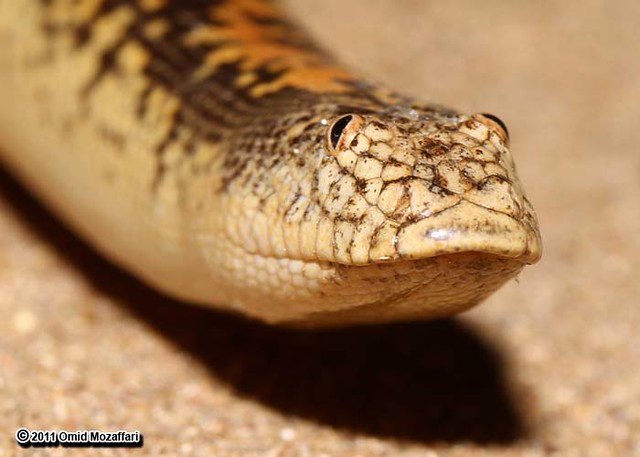
The Arabian sand boa resides in Saudi Arabia, Oman and Yemen, and has recently attracted fame for being the goofiest looking snake on the planet. This snake looks like one of those old cartoon characters who’ve been whacked on the head with a giant hammer and sees stars for a few seconds. Others have called it a kid’s drawing of a snake come to life.
The goofiness of this species is partly down to the extremely smooth body, which has no neck whatsoever and looks like a living sausage. However, it’s mainly down to the unusual eyes.
Like the Saharan horned viper, this snake’s eyes are positioned on top of its head rather than on the sides, a tactical evolution to maximise its vision when buried in desert sands. The eyes are unusual in many ways, being so close that they allow crossover binocular vision with full 3D.
The boomslang shares this feature, but the Arabian sand boa tops it off with diagonally angled pupils in an oval shape. Combine all this, and you have the strangest snake eyes around, and a permanently spaced out looking boa.
| 2 | Easily recognised |
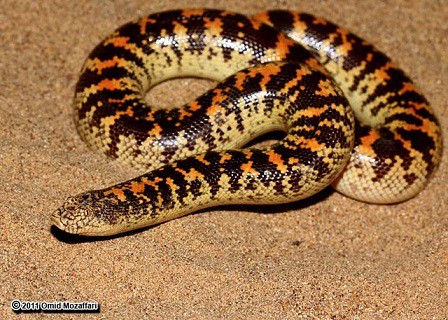
Goofiness aside, the Arabian sand boa is already more eye-catching than its fellow sand digger, the Saharan horned viper. Its belly is a consistent white, but its back has the colours of an Australian musical instrument, with deep orange and black interlocking in a series of haphazard stripes.
Its eyes are also more colourful than average. The pupils are pitch black, but the irises are an orange colour, lightening to almost white just before the pupils begin. Its mouth is spade-shaped, allowing the Arabian sand boa to dig down and spend most of its day below the sand.
Eryx jayakari is one of the smallest boa species worldwide, with adults averaging at 30-45cm. The boa constrictor averages at 2.5 metres, while even the Kenyan sand boa is slightly longer at 30-60cm. That said, they’re a thick bodied and muscular snake, which has no problem grabbing its prey and dragging them down like a nightmarish sandworm of science fiction.
| 3 | Is one with the sand |
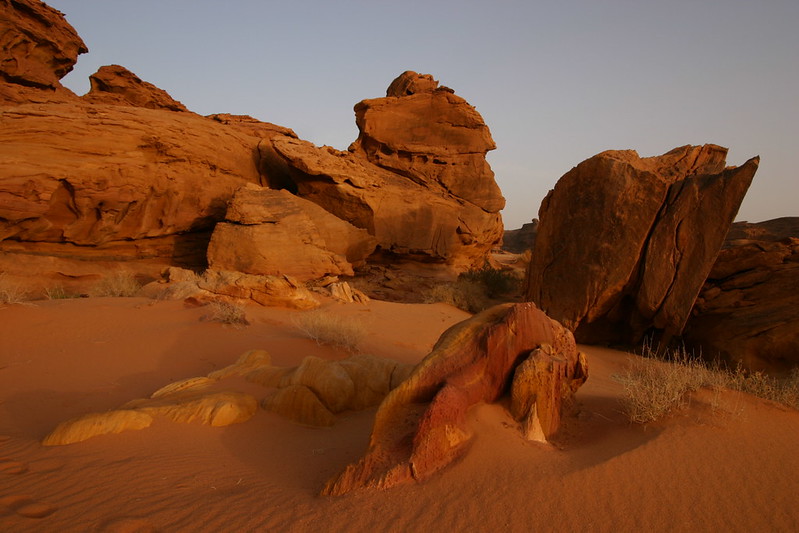
Eryx jayakari is the only boa to roam the Arabian peninsula in all its arid vastness. Arabian sand boas are also found in Iran, but only a tiny portion of the southwest, mostly the region of Khuzestan.
Sand deserts are their main habitat, but Arabian sand boas also appear in the shady shelter of oases. Another hangout is dry crop fields directly adjacent to deserts, where they shelter beneath corrugated iron, sheets of cardboard, and planks of wood.
Eryx jayakari is both a sand dweller and nocturnal. Consequently, it often goes unnoticed, and may be far more abundant than locals realise. In 2019, an Arabian sand boa was unearthed in the construction site of Dubai Expo 2020, a global event just south of the city hosting futuristic ideas and technology. Because of their smooth scales, Arabian sand boas can glide through the soft upper sands without ever surfacing.
| 4 | A sand-diving nightmare creature |
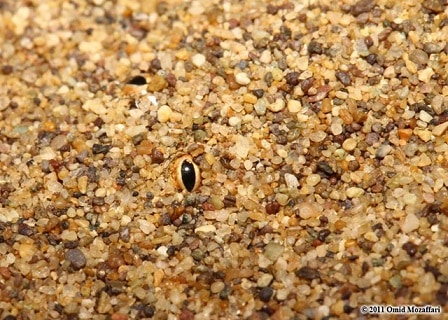
The Arabian sand boa uses constriction rather than venom to hunt. Its technique would be the stuff of nightmares if only it were a little larger. Instead of charging down desert dunes after terrified prey, the Arabian sand boa waits in the sand completely buried, with only its eyes poking out. Despite looking like the local village idiot, Eryx jayakari is patient, and carefully scans the horizon with its binocular vision.
When a rabbit or lizard comes into view, the Arabian sand boa does nothing. The second the prey comes close, the boa will strike not with a full-frontal assault, but with a sideways flick of its head, so that the rabbit is seized and dragged down instantly without the snake even leaving its hole.
For geckos, sand dunes are like a minefield; there could be an Arabian sand boa hidden anywhere. If its gerbil friends were accompanying it, they’d be wondering where their pal had disappeared to. Even entering the desert is a nightmare. This is the kind of situation that mythological creatures spring from.
| 5 | A rare egg-laying boa |
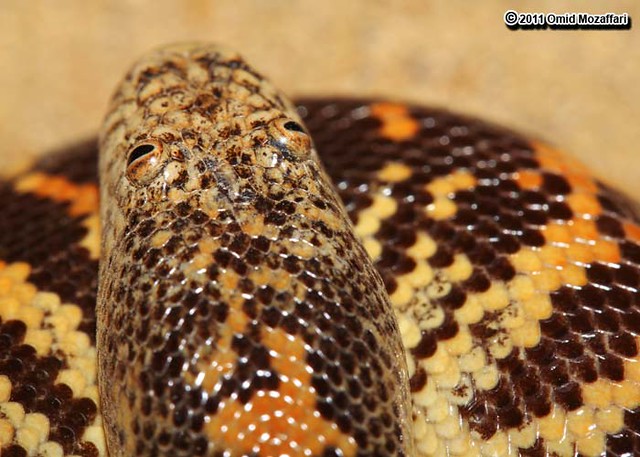
Arabian sand boas lay 7 eggs on average, which take 66 days to hatch. They’re a rarity in boas: one of only three species worldwide to lay eggs rather than live young. They’re also the only Eryx (old world sand boa) species to lay eggs. They’re thought to have re-evolved egg laying 60 million years after the 10-member Eryx family first switched to live birth.
The only problem is that in the process, Eryx jayakari apparently forgot to re-evolve the egg tooth that newborns need to hack free. To compensate, Arabian sand boa shells are unusually thin, and the young ram their way through with their heads.
It’s possible that the egg tooth gene was lost once and for all 60 million years ago, but it could be lying dormant, ready to reappear in a freak mutation, like those humans occasionally born with tails. Any newborn with the tooth would have dramatically higher survival changes, and the genes would probably spread again.
| 6 | How the species came to be |
It’s believed that the ancestor of Eryx jayakari began in western Asia, before invading the deserts of Arabia and kicking off a new evolution process. Today, the Arabian sand boa’s north-eastern neighbour is the dwarf sand boa (Eryx miliaris). This version inhabits Iran and Afghanistan, and has a familiar thick body and plastic eyes. Their sand digging tactics are also similar, while the differences include a longer length of 120cm, vertical pupils, and laying live young instead of eggs.
According to RNA testing, the dwarf sand boa has a close genetic relationship with the Arabian sand boa, so close that they probably share a common ancestor. The dwarf sand boa could even be the ancestor itself, with an offshoot leaving Iran and migrating southwards, never to return.
Meanwhile, another version is the central Asian sand boa (Eryx elegans). This has far more distant genetics, despite living close by in Turkmenistan and northern Iran.
| 7 | Capital: Ha’il province |
One particular hub for the Arabian sand boa is Ha’il province, a region of Saudi Arabia littered with history. In May 2012, a human settlement was dug up in Ha’il dating back 350,000 years, complete with hand axes and stone tools. Umm Senman mountain alone has 2000 ancient paintings, including 262 depicting humans, with some dating back to 7000BC.
Ha’il is littered with ruins such as Sayd, an ancient Islamic city founded in 1360AD, placed on the busy pilgrimage road from Baghdad. The city prospered for 500 years, but is now mostly reduced to sand-strewn walls.
In the days when old artefacts were forged, the world was gripped by an ice age, and Saudi Arabia was greener and replete with flowing rivers. Today, the once bustling trade routes have turned to desert. Yet the Arabian sand boa has prospered, and turned Ha’il province into its own sandy stronghold, surrounded by crumbling ruins. One of the snake’s main capitals within Ha’il is Nefud Al-Kebir, AKA the Great Sand Dune Desert, which was long said by locals to be impassable.
| 8 | Mostly eats reptiles |
When females were analysed in the deserts surrounding Riyadh, their diet consisted of 50% lizards, 25% mammals, 12.5% arthropods, and 12.5% unidentifiable (being too heavily digested). Arabian sand boas are nocturnal hunters, and their confirmed prey includes…
Baluch rock gecko (Bunopus tuberculatus) – a common gecko across the Arabian peninsula. An ambush predator, which lurks near boulders waiting for insects to pass. Has a large tail that leaves a clear trail in the sand.
Slevin’s sand gecko (Stenodactylus slevini) – combines long legs and huge eyes to look completely crazy, at least when young. Older ones are stockier and more menacing, particularly their amazing eyes, which combine orange, red and viciously vertical pupils. This gecko favours desert above all else.
Cheesman’s gerbil (Gerbilus cheesmani) – a doe-eyed rodent measuring 7-11cm. The Arabian sand boa shares this prey with the Saharan horned viper, another sand-diving snake. The latter is north African, but the two snakes just overlap in northwest Saudi Arabia.
Another lizard they eat is Acanthodactylus schmiditi, another rodent is Gerbilus nanus, and in 2017 an Arabian sand boa was spotted coughing up a purple sunbird (Cinnyris asiaticus).
| 9 | Prospering in the sandy desert |
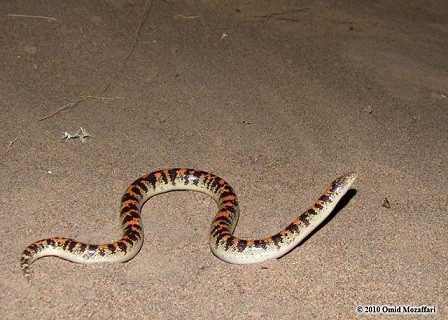
Even scientific surveys struggle to pick this snake up. In one diet study, scientists didn’t bother trying to spot the snakes, but searched for their old tracks in the desert, and followed the fine imprints across the dunes back to their sub-sand lairs.
The study also discovered that females were only slightly longer than males, at 39.0cm vs 38.8cm. Yet they were much thicker, with a diameter of 13cm versus 10.5cm. In a few Arabian regions, there’s also a darker morph, with much less noticeable patterns, but the distant Iranian colonies generally have similar colours to those in Saudi Arabia.
The Arabian sand boa has many wacked out days of wackiness ahead of it, as it’s a widespread species with a “least concern” IUCN conservation tag. The species has prospered simply by inhabiting harsh, 50 centigrade terrain where few humans dare to tread. It’s believed to occupy 19,750 square kilometres in total, although it’s a poorly surveyed species overall.
| 10 | The name’s origin |
Arabian sand boa makes sense, but where did the Latin name of Eryx jayakari come from? It originated from Atmaram Jayakar, a famous Indian naturalist who the Jayakar’s lizard is also named after. Jayakar (born 1844) came from the Pathare Prabhu ethnicity of Mumbai, and grew up under British colonialism. He eventually joined the semi-militarised Indian Medical Service, and was dispatched to Muscat, Oman in 1873, with the goal of improving the health of the desert-dwelling locals.
This little trip lasted for 30 years, during which Jayakar gained the nickname “Muscati” and personally treated Turki bin Sa’id, the Sultan of Muscat. Gradually, Jayakar became obsessed with the local wildlife, describing desert reptiles and 22 new species of fish. English explorer Theodore Bent described his house as “filled with curious animals from the interior, and marvels from the deep“.
Jayakar also described the Arabian tahr, an endangered goatlike animal which lives in Oman’s mountains. This too bears his name: Arabitragus jayakari.